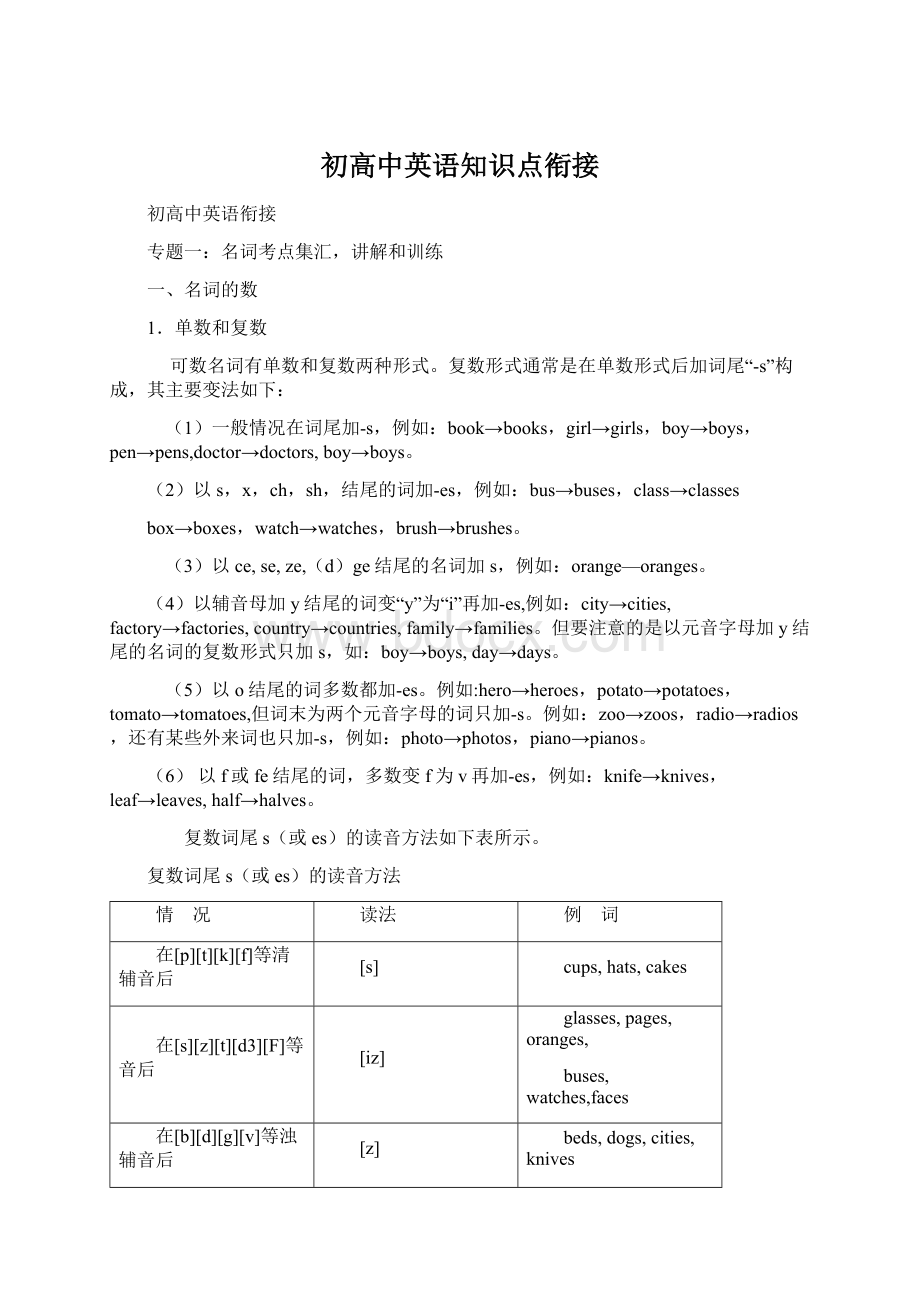初高中英语知识点衔接文档格式.docx
《初高中英语知识点衔接文档格式.docx》由会员分享,可在线阅读,更多相关《初高中英语知识点衔接文档格式.docx(82页珍藏版)》请在冰豆网上搜索。

buses,watches,faces
在[b][d][g][v]等浊辅音后
[z]
beds,dogs,cities,knives
(7)少数名词有不规则的复数形式,例如:
man→men,woman→women,tooth→teeth,foot→feet,child→children,mouse→mice。
【注意】与man和woman构成的合成词,其复数形式也是-men和-women。
anEnglishman,twoEnglishmen。
但German不是合成词,故复数形式为Germans;
man,woman等作定语时,它的单复数以其所修饰的名词的单复数而定,如:
men workers,womenteachers。
有个别名词单复数一样,例如:
Chinese,Japanese,sheep,deer,fish等。
但当fish表示不同种类的鱼时,可以加复数词尾。
(8)单数形式但其意为复数的名词有:
people,police等。
(9)数词+名词作定语时,这个名词一般保留单数形式,中间加连字符。
例如an8-year-oldgirl,aten-milewalk。
(10)还有些名词仅有复数形式,如:
trousers,clothes,chopsticks,glasses,goods,ashes,scissors,compasses。
(11)只用作单数的复数形式的名词有:
科学名词:
physics,mathematics/maths
游戏名称:
bowls
专有名词:
theUnitedStates,NiagaraFalls
其他名词:
news,falls
2.不可数名词“量”的表示方法
在英语中,不可数名词如果要表示“量的概念”,可以用以下两种方法:
(1)用much,alittle,alotof/lotsof,some,any等表示多少,例如:
Therichmanhasalotofmoney.
Thereissomemilkinthebottle.
Isthereanywaterintheglass?
Idon'
tlikewinterbecausethere'
stoomuchsnowandice.
(2)用apieceof这类定语,例如:
apieceofpaperapieceofwoodapieceofbread
abottleoforangeaglassofwater(milk)acupoftea
acupofteaabagofricethreebagsofrice
如果要表示“两杯茶”、“四张纸”这类概念时,在容器后加复数,例如:
twocupsoftea
fourpiecesofpaper
threeglassesofwater
不可数名词也可用alotof,lotsof,some,any,much等来修饰。
二、名词的所有格
名词所有格,用来表示人或物的所有,以及领属关系。
1.表示有生命的名词的所有格其单数形式是加'
s,其复数形式是s'
,例如:
astudent'
sroom,students'
rooms,father'
sshoes。
2.如其结尾不是s的复数形式仍加'
s,如:
Children'
sDay。
3.在表示时间、距离、长度、重量、价格、世界、国家等名词的所有格要用'
s,例如:
atwentyminutes'
walk,tenmiles'
journey,aboat'
slength,twopounds'
weight,tendollars'
worth。
4.无生命名词的所有格则必须用of结构,例如:
amapofChina,theendofthisterm,thecapitalofourcountry,thecoloroftheflowers。
5.双重所有格,例如:
afriendofmyfather'
s。
【注意】
如果两个名词并列,并且分别有'
s,则表示“分别有”,例如:
John'
sandMary'
srooms(约翰和玛丽各有一间,共两间);
Tom'
sbikes(两人各自的自行车)。
两个名词并列,只有一个'
s,则表示“共有”,例如:
JohnandMary'
sroom(约翰和玛丽共有一间);
TomandMary'
smother(即Tom与Mary是兄妹)。
【演练】
1.---Wherehaveyoubeen,Tim?
---I’vebeento______.
A.theHenryhouse
B.theHenryfamily
C.TheHenry’shome
D.Henry’s
2.InEngland,if____isinthemiddleoftheday,theeveningmealiscalledsupper.
A.food
B.lunch
C.breakfast
D.dinner
3.Youlookedforittwice,butyouhaven’tfoundit.Whynottry____.
A.threetimes
B.athirdtime
C.thethirdtime
D.once
4.---Theyarethirsty.Willyoupleasegivethem______?
---Certainly.
A.somebottlesofwaters
B.somebottlesofwater
C.somebottleofwater
D.somebottleofwaters
5.Mikehurtoneofhis______intheaccidentyesterday.
A.tooth
B.feet
C.hand
D.ear
6.Thereissome_______ontheplate.
A.cakes
B.meat
C.potato
D.pears
7.InEngland,thelastnameisthe
_______.
A.familyname
B.middle
C.givenname
D.fullname
8.Theyaregoingtofly_______toBeijing.
A.Germen
B.Germany
C.Germanys
D.Germans
9.The______hastwo_______.
A.boys;
watches
B.boy;
watch
C.boy;
D.boys;
watch
10.Thelittlebabyhastwo_______already.
B.tooths
C.teeth
D.teeths
11.What’syour_______forbeinglateagain?
A.idea
B.key
C.excuse
D.news
12.---It’sdangeroushere.We’dbettergooutquickly.
---ButIthinkweshouldlet_______gooutfirst.
A.womanandchildren
B.womenandchild
C.womanandchild
D.womenandchildren
13.---YoucanseeMr.Smithifthereisasign“_______”onthedoorofhisshop.
---Thanks.
A.ENTRANCE
B.BUSINESSHOURS
C.THISSIDEUP
D.NOSMOKING
14.Aretheygoingtohaveapicnicon_______?
A.Children’sDay
B.Childrens’sDayC.ChildrensDay
D.ChildrenDay
15.Wherearethestudents?
Aretheyin_______?
A.theRoom406
B.Room406
C.the406Room
D.406Room
【练习答案】
1.D2.B3.B4.B5.B
6.B7.A8.D9.C10.C
11.C12.D13.B14.A15.B
专题二:
形容词、副词考点集汇,讲解和训练
【名师点睛】
1.形容词的用法
(1)形容词在句中作定语,表语,宾语补足语。
例如:
Ourcountryisabeautifulcountry.(作定语)
Thefishwentbad.(作表语)
Wekeepourclassroomcleanandtidy.(作宾语补足语)
(2)形容词修饰something,anything,nothing,everything等不定代词时,形容词放在名词后面。
Ihavesomethingimportanttotellyou.
Isthereanythinginterestinginthefilm.
(3)用and或or连接起来的两个形容词作定语时一般把它们放在被修饰的名词后面。
起进一步解释的作用。
Everybody,manandwoman,oldandyoung,shouldattendthemeeting.
Youcantakeanyboxaway,bigorsmall.
(4)the+形容词表示一类人或物
Therichshouldhelpthepoor.
2.副词的用法
(1)副词在句中可作状语,表语和定语。
Hestudiesveryhard.(作状语)
Lifehereisfullofjoy.(作定语)
Whenwillyoubeback?
(作表语)
副词按其用途和含义可分为下面五类:
1)时间副词
时间副词通常用来表示动作的时间。
常见的时间副词有:
nowtoday,tomorrow,yesterday,before,late,early,never,seldom,sometimes,often,usually,always等。
Heoftencomestoschoollate.
Whatarewegoingtodotomorrow?
HeisneverbeentoBeijing.
2)地点副词
地点副词通常用来表示动作发生的地点。
常见的地点副词有:
here,there,inside,outside,home,upstairs,downstairs,anywhere,everywhere,nowhere,somewhere,down,up,off,on,in,out等。
Imetanoldfriendofmineonmywayhome.
Hewentupstairs.
Putdownyournamehere.
3)方式副词
方式副词一般都是回答“怎样的?
”这类问题的,其中绝大部分都是由一个形容词加词尾-ly构成的,有少数方式副词不带词尾-ly,它们与形容词同形。
常见的方式副词有:
anxiously,badly,bravely,calmly,carefully,proudly,rapidly,suddenly,successfully,angrily,happily,slowly,warmly,well,fast,slow,quick,hard,alone,high,straight,wide等。
Theoldmanwalkedhomeslowly.
Pleaselistentotheteachercarefully.
Thebirdsareflyinghigh.
Herunsveryfast.
4)程度副词
程度副词多数用来修饰形容词和副词,有少数用来修饰动词或介词短语。
常见的程度副词有:
much,(a)little,abit,very,so,too,enough,quite,rather,pretty,greatly,completely,nearly,almost,deeply,hardly,partly等。
Herpronunciationisverygood.
Shesingsquitewell.
Icanhardlyagreewithyou.
5)疑问副词是用来引导特殊疑问句的副词。
常见的疑问副词有:
how,when,where,why等。
Howareyougettingalongwithyourstudies?
Wherewereyouyesterday?
Whydidyoudothat?
(2)副词在句中的位置
1)多数副词作状语时放在动词之后。
如果动词带有宾语,则放在宾语之后。
MrSmithworksveryhard.
ShespeaksEnglishwell.
2)频度副词作状语时,通常放在行为动词之前,情态动词,助动词和be动词之后。
Heusuallygetsupearly.
I’veneverheardhimsinging.
Sheisseldomill.
3)程度副词一般放在所修饰的形容词和副词的前面,但enough作副词用时,通常放在被修饰词的后面。
Itisaratherdifficultjob.
Hedidn’tworkhardenough.
4)副词作定语时,一般放在被修饰的名词之后。
Onmywayhome,Imetmyuncle.
Thestudentstherehavealottimetodotheirownresearchwork.
(3)部分常用副词的用法
1)very,much
这两个副词都可表示“很”,但用法不同。
Very用来修饰形容词和副词的原级,而much用来修饰形容词和副词的比较级。
Sheisaverynicegirl
I’mfeelingmuchbetternow.
Much可以修饰动词,而very则不能。
Idon’tliketheideamuch.
Theydidnottalkmuch.
2)too,either
这两个副词都表示“也”,但too用于肯定句,either用于否定句。
Shecandance,andIcandance,too.
Ihaven’treadthebookandmybrotherhasn’teither.
3)already,yet
already一般用于语肯定句,yet一般用于否定句。
Hehasalreadyleft.
Haveyouheardfromhimyet?
Hehasn’tansweredyet.
4)so,neither
so和neither都可用于倒装句,但so表示肯定,neither表示否定。
MybrotherlikesfootballandsodoI.
Mybrotherdoesn’tlikedancingandneitherdoI.
3.形容词和副词的比较级和最高级
(1)两个人或事物的比较时(不一定每一方只有一个人或一个事物),用比较级。
Ourteacheristallerthanweare.
Theboysinherclassaretallerthantheboysinyourclass.
(2)most同形容词连用而不用the,表示"
极,很,非常,十分"
。
It'
smostdangeroustobehere.
在这儿太危险。
(3)“The+形容词比较级...,the+形容词比较级...”表示“越...就越...”。
Themoreyoustudy,themoreyouknow.
(4)“形容词比较级+and+形容词比较级”,表示“越来越...”。
sgettinghotterandhotter.
(5)主语+谓语(系动词)+as+形容词原形+as+从句。
表示两者对比相同。
Thisboxisasbigasmine.
(6)the+形容词,表示某种人。
Healwayshelpsthepoor.
(7)形容词和副词最高级用于三个或三个以上的人和物进行比较。
ShanghaiisoneofthebiggestcitiesinChina.
1.Therearemanyyoungtreeson
sidesoftheroad.
A.every
B.each
C.both
D.all
2.---It’ssocoldtoday.
---Yes,it’s
thanitwasyesterday.
A.morecold
B.morecolder
C.muchcolder
D.cold
3.LittleTomhas
friends,soheoftenplaysalone.
A.more
B.alittle
C.many
D.few
4.Sheisn’tso
atmathsasyouare.
A.well
B.good
C.better
D.best
5.Peterwrites
ofthethree.
A.better
B.best
C.good
D.well
6.Heis
enoughtocarrytheheavybox.
A.stronger
B.muchstronger
C.strong
D.thestrongest
7.Ibought
exercise-bookswith
money.
A.afew;
afew
B.afew;
alittle
C.alittle;
D.alittle;
alittle
8.Theboxis
heavyforthegirl
carry.
A.too;
to
B.to;
too
C.so;
that
D.no;
to
9.Theiceinthelakeisaboutonemeter
.It’sstrongenoughtoskateon.
A.long
B.high
C.thick
D.wide
10.WuLinran